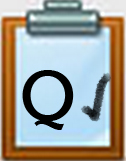Q6 Evaluation: Improve & Feedback
Improve YOur Work through Feedback
You chose a complex problem to work on and you used the four stages of computational thinking to create a solution with your documentation in your Computational Thinking Planning Document. Now let's take it through an evaluation process to improve its effectiveness and/or to inform programming decisions.
Open your Computational Thinking Planning Document. While reading through the content below and watching the video, record your work in your document.
Step 1. Let's first learn what it means to provide constructive feedback. Feedback is important because it helps you improve your work by getting opinions and ideas from others. For example, if you were designing a new game for your phone, you would want to know what players think about it. Their feedback could help you make changes to the game, like adjusting the rules or improving the gameplay, to make it better.
- Play the video below to learn about five things you should do when providing feedback.
Understanding How Feedback Works
Direct link (1:28 min.)
Step 2. Create a way to collect your feedback.
- You can gather feedback informally by talking to your peers or intended audience if you designed it for another age group.
- You can gather feedback by creating a survey using Google Forms, Survey Monkey, or Microsoft Forms.
- If you have never used either program here are tutorials to assist you.
- Finalize how you are going to ask for feedback and what questions you are going to ask. Refer to box six in your Computational Thinking Planning Document to help guide you with some questions.
Step 3. Choose an individual or a group to whom you will present your complex problem and describe the problem you have chosen to them.
- Depending on the problem, you might focus on the process and/or the outcome. The process is the work you did in each quest of the four stages of computational thinking. The outcome is the result you achieved when you completed all the tasks to solve your complex problem.
- Ask your audience to provide feedback based on your work in Step 2.
- Encourage your peers to give you constructive feedback which they learned about when they played the video in Step 1. This is honest feedback and advice that will help you improve the final outcome.
Step 4. After gathering feedback, you need to draw conclusions after learning about the strengths and weaknesses of your complex problem's solution.
- Do you need to revise the process to improve the solution?
- What could you change after reviewing the feedback?
- Depending on time, your teacher may have you use the feedback to revise and perfect your complex problem. Follow your teacher's instructions for revisions.
Competencies and Standards
MITECS Michigan Integrated Technology Competencies for Students, and
1. Empowered Learner
a. Articulate and set personal learning goals, developing strategies leveraging technology to achieve them, and reflect on the learning process itself to improve learning outcomes
c. Use technology to seek feedback that informs and improves their practice and to demonstrate their learning in a variety of ways
3. Knowledge Constructor
a. plan and employ effective research strategies to locate information and other resources for their intellectual or creative pursuits
b. evaluate the accuracy, perspective, credibility and relevance of information, media, data or other resources
c. curate information from digital resources using a variety of tools and methods to create collections of artifacts that demonstrate meaningful connections or conclusions
d. build knowledge by actively exploring real-world issues and problems, developing ideas and theories and pursuing answers and solutions
5. Computational Thinker
a. Formulate problem definitions suited for technology assisted methods such as data analysis, abstract models and algorithmic thinking in exploring and finding solutions
b. Collect data or identify relevant data sets, use digital tools to analyze them, and represent data in various ways to facilitate problem-solving and decision-making
c. Break problems into component parts, extract key information, and develop descriptive models to understand complex systems or facilitate problem-solving
d. Understands how automation works and use algorithmic thinking to develop a sequence of steps to create and test automated solutions




